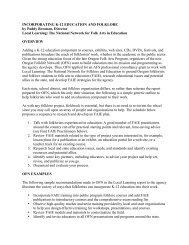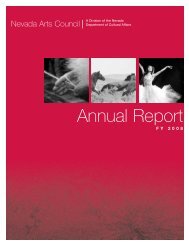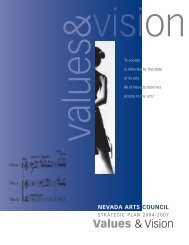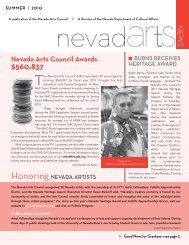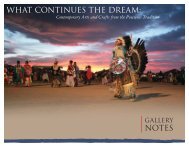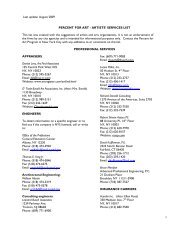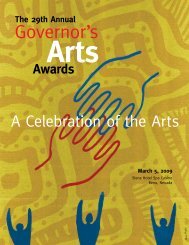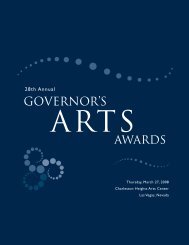Handed Down - Nevada Arts Council
Handed Down - Nevada Arts Council
Handed Down - Nevada Arts Council
Create successful ePaper yourself
Turn your PDF publications into a flip-book with our unique Google optimized e-Paper software.
1991–1992<br />
Basque Dance:<br />
Jesus Larrea and Lisa Corcostegui<br />
Basque culture is imbedded deep in the history of<br />
the American West, and maintains strong living<br />
connections to its European homeland that have kept<br />
it alive and vital here. A very personal connection was<br />
made when the apprenticeship program allowed Basque<br />
dance master Jesus Larrea to spend a month in Reno<br />
with Lisa Corcostegui, director of the University of<br />
<strong>Nevada</strong>’s Zenbat Gara Basque Dancers.<br />
Jesus started dancing as a teenager with a group from<br />
his school in San Sebastian, and by age 18 he was good<br />
enough to join one of the area’s semi-professional dance<br />
troupes, Argia. Argia’s director has done extensive field<br />
research on traditional village dances and celebrations,<br />
and has even helped revive dances that were almost lost<br />
after the Spanish Civil War. Jesus is now an instructor<br />
with Argia, and has performed with the group all<br />
over the Basque Country, as well as in Italy, Hungary,<br />
Czechoslovakia, France, Cuba and the United States. He<br />
and List first met when they were both performing at an<br />
international Basque festival in the summer of 1990.<br />
was little. My grandma used to tell us stories, too, about<br />
where she lived when she was young and the things she<br />
used to do over there, and it just seemed, you know,<br />
magical almost.” Lisa’s dream came true when she was<br />
able to visit the country for a summer, and then return<br />
for 2 ½ years as part of UNR’s Basque Studies Program.<br />
Lisa, her Basque husband Enrique, and a few friends<br />
put together a dance for a University ethnic celebration<br />
in 1989, and from that was born the Zenbat Gara<br />
Dancers. The company now numbers 20, and has performed<br />
all over the West. Working intensively with Jesus<br />
allowed Lisa to learn many more dances, both solo<br />
and group, from every region of the Basque country.<br />
The benefits of personal instruction were invaluable;<br />
she says, “Some things you can learn off a video, more<br />
or less, and other things, just forget it. And this is one<br />
of those things you have to have somebody who knows<br />
what they’re doing to teach you how to do it.” Jesus<br />
also worked with Zenbat Gara while he was in Reno,<br />
as well as with the children’s dance group of the Reno<br />
Basque Club; his wife even came with him and helped<br />
the group make some authentic new costumes to go<br />
with the new dances. It is exchanges like these that keep<br />
<strong>Nevada</strong>’s Basque community very much alive and connected<br />
to its roots.<br />
Jesus teaching Lisa and other members<br />
of the Zenbat Gara Dancers.<br />
Lisa was raised in Ontario, Oregon, near the Idaho<br />
border and her parents’ home town of Nampa. Her<br />
Basque mother and grandmother instilled an early love<br />
of Basque culture, and Lisa started dancing when she<br />
was just four or five years old. “I always wanted to go to<br />
the Basque country, and I always wanted to do anything<br />
Basque,” she says. “Every time I had to do a report, you<br />
know, and you could write on whatever you wanted, always<br />
Basque this, Basque that, Basque whatever. I was<br />
just in love with the culture, I always was, ever since I<br />
Lisa Corcostegui and Jesus Larrea.<br />
19




